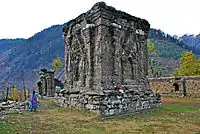Amb Temples
The Amb Temples (Urdu: امب مندر), locally known as Amb Sharif (Urdu: امب شریف; "Noble Amb"), are part of an abandoned Hindu temple complex on the Sakesar mountain, located at the western edge of the Salt Range in Pakistan's Punjab province. The temple complex was built in the 7th to 9th centuries CE during the reign of the Hindu Shahi empire.[1]
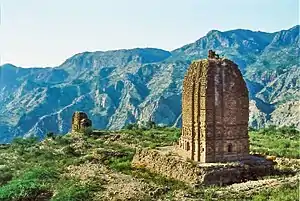 The site consists of the ruins of two temples located in Pakistan's Salt Range mountains | |
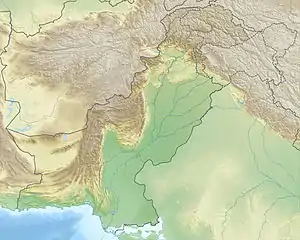 Shown within Pakistan 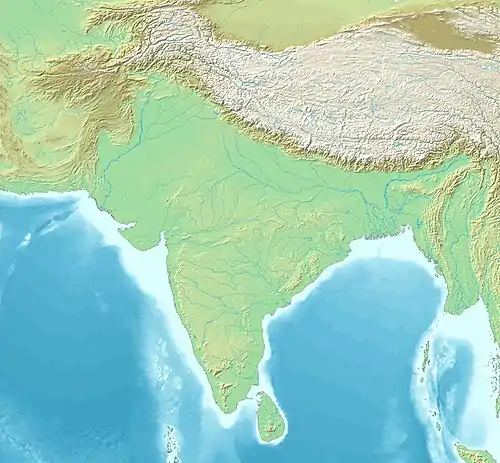 Amb Temples (South Asia) | |
| Location | Khushab District Punjab Pakistan |
|---|---|
| Region | Salt Range mountains |
| Coordinates | |
| Type | Temple complex |
| History | |
| Founded | 7-9th century CE |
| Periods | Hindu Shahi |
| Cultures | Punjabi Hindu |
Location
The ruins are located near Amb Sharef village, on Sakesar mountain in the Soon Valley of Pakistan. The ruins form the westernmost ruins of a string of Hindu temples in the Salt Range mountains that includes the Katas Raj Temples and Tilla Jogian monastic complex.
Historical Context
Art and Culture Columnist Souhardya De, in his article for The Sunday Guardian talks about the context of the temples being forgotten and negated. He quotes, "The Hindu Shahis stood at a face off against the Ghaznavids, under Anandpal’s leadership, for one ultimate time, primarily to decide the fate of the nation, the northern boundaries of what they stood guarding for almost two centuries: Hindustan! With Jayapaldeva’s humiliating defeat at the hands of Mahmud in 1001 CE, Anandpal, Jayapal’s son and a favourable successor of the centuries old Hindu Shahis, had come forward to lead a confederacy of the local rajahs and the almost extirpated Kshatriyas, against Mahmud. An intense battle was what kicked off next, on the rugged fertile plains of Chhachh, (“a region located between Peshawar and Islamabad at the northern tip of Attock”), in which Anandpal, the king who was then considered as an invincible descendant of Porus, ended the battle the similar way his probable ancestor had ended one with Alexander, thirteen hundred years ago: a truce! History had to repeat itself and once again, the boundaries of the nation fell short for keeping the invaders at bay. Mahmud returned pompous and his purpose to loot the moneyed kingdoms of Hindustan, was partially accomplished. Two years later, in 1010 CE, Anandpal, the king upon whose tactics the masses had placed their hopes high, passed away under normal circumstances, and a massive financial and territorial possession of the Hindu Shahis was lost to Ghazni. Trilochanapala, son of the great king, sat on the gilded throne next but failed miserably to restore the dynastic prestige to its previous stature. Executed by his own soldiers in 1021 CE, he was succeeded by Bhimpala of whom not much is known other than the fact that he was possibly the very last of the once powerful Hindu Shahis. With his death, the empire that once stood guarding the borders of Hindustan like none other, faded away into uncertainty and was absorbed by internal conflicts and foreign invasions that led to the rise of the Saffarids, the Samanids and the Ghaznavids. Their monumental forts and palaces soon waned into desolation, dying in despondency, and the region, culturally and religiously now, populated with people of the Islamic faith, failed even to recall the once massive temples (Tilla Jogian, Nandana, Katas, Malot, Amb, Kafir Kot and others) dotting the Sakesar Salt range."[2]
Architecture
The main temple is roughly 15 to 20 metres tall, and built out of brick and mortar on a square plinth. It is regarded as the "loftiest" of temples built by the Hindu Shahi empire.[3] The temple ruins have three stories, with stairwells leading to inner ambulatories.[4]
The temple is decorated with Kashmiri style motifs on its exterior, including a cusped niche.[4] The structure of the main temple, differs from Kashmiri temples which typically have pointed tops.[4] The main temple is instead similar in style to the nearby Kalar temple, and Kafir Kot temple in Khyber Pakhtunkhwa province.[5]
To the west about 75 metres lies another smaller temple, which is 2 story or 7 to 8 meters high,[6] situated near a cliff. The temple features a small vestibule chamber facing towards the main temple. It was a few metres from a second similarly sized temple, which no longer exists.[4] The entire temple complex was surrounded by a fortification, with the earliest construction at the site dating to the late Kushan period.[4]
Conservation
The site was visited by Alexander Cunningham in the late 19th century, and was partly conserved in 1922-24 by Daya Ram Sahni.[4] The temple had been looted over the centuries, with the last remaining statuary removed from the site in the late 19th century and placed in the Lahore Museum.[4] The site is currently protected by Pakistan's Antiquities Act (1975).
Gallery
 The main temple
The main temple The main temple features a Kashmiri-style cusped archway
The main temple features a Kashmiri-style cusped archway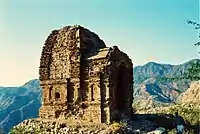 A view of the smaller temple with its vestibule chamber
A view of the smaller temple with its vestibule chamber The base of the main temple
The base of the main temple A view of the main temple's plinth
A view of the main temple's plinth
See also
References
- Gazetteer of the Attock District, 1930, Part 1. Sang-e-Meel Publications. 1932. Retrieved 21 September 2017.
- "Amb Sharif: The Effaced Cardinal Remnants of the Hindu Shahis". The Sunday Guardian Live. 2 January 2021. Retrieved 3 January 2021.
- Rashid, Salman (2001). The Salt Range and the Potohar Plateau. Sang-e-Meel Publications. ISBN 9789693512571. Retrieved 21 September 2017.
- Meister, Michael (2005). "Fig Gardens of Amb-Sharif, Folklore and Archaeology". East and West. Istituto Italiano per l'Africa e l'Oriente. 55 (1/4): 201–216. JSTOR 29757645.
- Journal of the Royal Asiatic Society of Great Britain and Ireland. Cambridge University Press for the Royal Asiatic Society. 1903. Retrieved 21 September 2017.
- Sakesar temple
